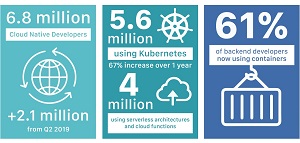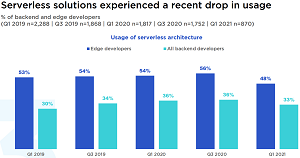News
Report Details Huge Growth in Cloud-Native Tech, Led by Kubernetes
For the third time, the Cloud Native Computing Foundation (CNCF) has published a "State of Cloud Native Development Report" developed by research firm SlashData, showing huge growth in cloud-native tech.
That growth is especially apparent with Kubernetes, which has grown from its early days as just a container orchestration system to be called "the operating system for the Cloud" and "the foundation of distributed infrastructures."
"Kubernetes has demonstrated impressive growth over the past 12 months," the CNCF said in a Dec. 20, 2021, blog post that pointed out it's used by some 5.6 million developers. "This represents a 67 percent increase from a year ago when, adjusting for a change in the question methodology, there were 3.9 million Kubernetes developers worldwide. This group now represents 31 percent of all backend developers, an increase of 4 percentage points in the last year."
 [Click on image for larger view.] Report Highlights (source: CNCF/SlashData).
[Click on image for larger view.] Report Highlights (source: CNCF/SlashData).
Going beyond just Kubernetes, the first CNCF/SlashData report in May 2020 counted 4.7 million cloud-native developers, while the second one in August 2020 showed a jump to 6.5 million, which has grown to some 6.8 million in this new third edition.
The CNCF's definition of cloud native reads:
Cloud native technologies empower organizations to build and run scalable applications in modern, dynamic environments such as public, private, and hybrid clouds. Containers, service meshes, microservices, immutable infrastructure, and declarative APIs exemplify this approach. These techniques enable loosely coupled systems that are resilient, manageable, and observable. Combined with robust automation, they allow engineers to make high-impact changes frequently and predictably with minimal toil.
Along with Kubernetes, other examples of cloud-native tech include Docker, microservices, serverless computing, APIs, CI/CD, service meshes and so on.
However, as cloud-native development has grown in general, some areas have lagged.
"While cloud native overall has seen growth in the past year, the proportion of backend developers involved in cloud native technologies declined slightly from 44 percent to 41 percent," the CNCF said. "This is in part due to a large increase in the overall number of backend developers and to a drop in the adoption of serverless architecture. While the total number of developers involved in serverless architecture stayed the same at 4 million, the proportion of developers involved in serverless architecture decreased from 27 percent to 24 percent."
 [Click on image for larger view.] Less Serverless (source: CNCF/SlashData).
[Click on image for larger view.] Less Serverless (source: CNCF/SlashData).
The above information constitutes one of seven key insights revealed by the report as identified by CNCF, with the full list being:
-
The global number of cloud native developers has grown in the last 12 months by 0.3 million, to 6.8 million. At the same time, the
proportion of backend developers involved in cloud native technologies has declined by 3 percentage points from 44 percent to 41 percent.
-
Across regions, North America (47 percent) and Western Europe (46 percent) have the highest adoption rates. Overall, larger organisations and more
experienced developers in these regions are driving adoption.
-
Kubernetes is used by 31 percent of all backend developers, which is an increase of 4 percentage points in the last 12 months. Currently, 5.6M*
developers use Kubernetes.
-
Across sectors, edge computing has experienced rapid growth in the adoption of Kubernetes and now has the highest usage rates of both
containers and Kubernetes.
-
Among edge developers only, Kubernetes usage increased in the last 12 months by 11 percentage points to 63 percent. Edge technology has the
highest adoption rate among all surveyed sectors.
-
Serverless architecture is also appealing to edge developers: 48 percent of all edge developers are using serverless compared to just 33 percent of all
backend developers.
-
Among serverless tools, AWS Lambda continues to be in the driving seat. However, Google Cloud Run has been gaining considerably in
the last 12 months.
The Dec. 20 post also summarizes the main points.
"With an increase of 300,000 developers, cloud native is still growing, but it is ostensibly growing at a slower rate than the last report, which saw a 1.8 million increase," the CNCF said. "One interesting trend is regarding large organizations with more than 500 employees the adoption of both Kubernetes and containers skyrockets, which means Kubernetes has safely met the needs of the enterprise.
"Another consideration is that developers are using Kubernetes without being aware of it. While overall awareness of Kubernetes has significantly increased since last year, many backend developers remain unsure of what it can do for them -- 21 percent say they have heard of Kubernetes but are unsure what it does while 11 percent say they have never heard of it. As we inferred last year, developers may not realize that many of the most popular services use Kubernetes under the hood. When you consider that 61 percent of backend developers report using containers, while 31 percent say they use Kubernetes and 28 percent say they use container orchestration tools, there appear to be some gaps in understanding how the technologies are interconnected."
The organization said it plans to explore those topics in its next report, coming early this year.
Methodology for the latest report is as follows: The analysis is based on the 20th edition of SlashData's Developer Economics survey, which ran between November 2020 and February 2021 and reached more than 19,000 developers globally. 3,800+ survey participants answered questions relating to the development of backend services and the technologies they use.
About the Author
David Ramel is an editor and writer at Converge 360.